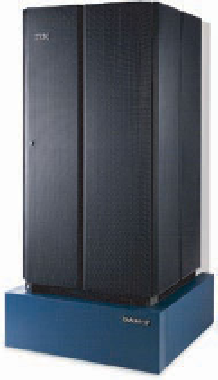Information Technology Reference
In-Depth Information
Mainframe Computers
A
mainframe computer
is a large, powerful computer shared by dozens or even hundreds of
concurrent users connected to the machine over a network. The mainframe computer must
reside in a data center with special heating, ventilating, and air-conditioning (HVAC) equip-
ment to control temperature, humidity, and dust levels. In addition, most mainframes are
kept in a secure data center with limited access to the room. The construction and mainte-
nance of a controlled-access room with HVAC can add hundreds of thousands of dollars to
the cost of owning and operating a mainframe computer.
The role of the mainframe is undergoing some remarkable changes as lower-cost, single-
user computers become increasingly powerful. Many computer jobs that used to run on
mainframe computers have migrated onto these smaller, less-expensive computers. This
information-processing migration is called
computer downsizing
.
mainframe computer
A large, powerful computer often
shared by hundreds of concurrent
users connected to the machine via
terminals.
Mainframe computers have been
the workhorses of corporate
computing for more than 50 years.
They can support hundreds of users
simultaneously and handle all of the
core functions of a corporation.
(Source: Courtesy of IBM
Corporation.)
The new role of the mainframe is as a large information-processing and data-storage utility
for a corporation—running jobs too large for other computers, storing files and databases
too large to be stored elsewhere, and storing backups of files and databases created elsewhere.
The mainframe can handle the millions of daily transactions associated with airline, auto-
mobile, and hotel/motel reservation systems. It can process the tens of thousands of daily
queries necessary to provide data to decision support systems. Its massive storage and input/
output capabilities enable it to play the role of a video computer, providing full-motion video
to multiple, concurrent users. IBM mainframe computer customers include the top 25 banks
and the top 25 retailers in the world who use the machines for processing large amounts of
transactions. For example, the Bank of China houses 350 million accounts with 3 billion
transaction histories and processes 30 million transactions in less than an hour using IBM's
System z mainframe computer.
59
Supercomputers
Supercomputers
are the most powerful computers with the fastest processing speed and
highest performance. They are
special-purpose machines
designed for applications that require
extensive and rapid computational capabilities. Originally, supercomputers were used pri-
marily by government agencies to perform the high-speed number crunching needed in
weather forecasting and military applications. With recent reductions in the cost of these
machines, they are now used more broadly for commercial purposes.
The IBM Blue Gene/L supercomputer was designed and built in collaboration with the
Department of Energy and the Lawrence Livermore National Laboratory. This basketball
court-size, number-crunching monster supports a wide range of research projects, ranging
from detailed simulations of nuclear weapons programs to human biological processes such
as protein folding. When comparing the speed of supercomputers, the metric used is floating-
point operating instructions per second, or FLOPS. The Blue Gene/L supercomputer has a
peak computational speed of 596 TeraFLOPS (1 TeraFLOP = 10
12
floating-point operations
supercomputers
The most powerful computer sys-
tems with the fastest processing
speeds.


